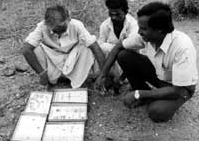Gabriele Stoll
Natural Crop Protection in the Tropics
Letting Information Come to Life
Letting information come to life
|
|
||
|
Farmers‘ research on
Natural Crop Protection
|
|
|
|
|
 |
|
Letting information come to life
Farmers‘ research on Natural Crop
Protection
by Daniel Anand Raj & Chitra Suresh
AME Tiruchi
Background
The report from AME in India describes an
informal and spontaneous kind of farmer experimentation. The
innovations of the two farmers presented in this case study
were inspired by knowledge they gained from season-long
training in Integrated Pest Management (IPM). Since 1997, AME
(AGRICULTURE, MAN & ECOLOGY), in collaboration with partner
NGOs has organized and developed a number of season-long
Farmers Field Schools (FFS) in rice, cotton and groundnut
cultivation. Methodological competence was augmented when
required, by hiring a resource person from the Department of
Agriculture (DoA) on consultancy basis.
The training covers crop production,
physiology, agronomy, crop protection, water management,
nutrient management etc. As the sessions are tailored to
specific stages of crop growth, these provide the best possible
understanding of the crop and its ecosystem to the farmers.
AME's vision
The aim of AME is to make the farmer an
expert in managing her/his own agro-ecosystem, wherein s/he
takes decisions independently. While making decisions, the
farmer takes into account all relevant factors to arrive at the
best possible judgement, resulting in better profitability. AME
tries to stimulate a process of attitudinal change among the
farmers and NGO staff to enable them to realize that the
intensive application of chemical inputs does not always bring
about a proportionate increase in returns. So each farmer has
to decide on the best possible combination of solutions for
her/his field.
Triggering farmer innovations
The two cases presented below are selected
examples from among many farmer innovations inspired by
knowledge acquired through participating in the FFS. Farmers
have quickly grasped various concepts discussed and observed in
the field, and were able to recognize mechanisms that were
being applied to materials and resources within their reach.
The innovations attempted by them related to addressing
different problems and aspects of crop cultivation, including
crop protection, which have relevance to their local needs and
constraints.
Critical aspects of farmer innovations
From AME's experience it can be observed
that some innovations are correct, whereas others need to be
reflected upon and worked out further. Even if the farmers are
by and large on the right track, it is important for them to
understand what is right or wrong with their initiatives.
Farmers are not always in a position to follow precisely the
recommendations from the trainings. So there are deviations,
which can result in positive outcomes at times, and negative
effects at others. These deviations are observed, discussed and
reflected upon by the local partner NGO and AME with the
respective farmer and options suggested.
However, AME leaves the final
decision-making on how to pursue the questioned practice to the
farmer. It can also be proposed that the farmer conducts
another comparison to sharpen her/his decision.
Reference insect box made by the farmers
containing the commonly occuring pest and benefical insects.
The printed version contains more
information about the following themes:
Following up farmer innovations
Verifying farmer innovations
Stakeholders
CASE 1
Rice Farmer in Tiruchi District
CASE 2
Cotton farmers in Tiruchirapalli
The meaning of farmer innovations and the
road ahead
